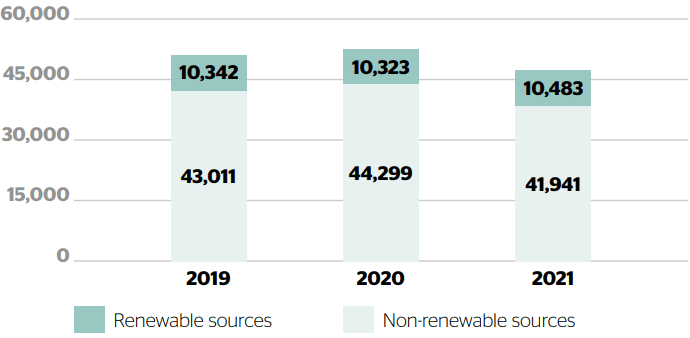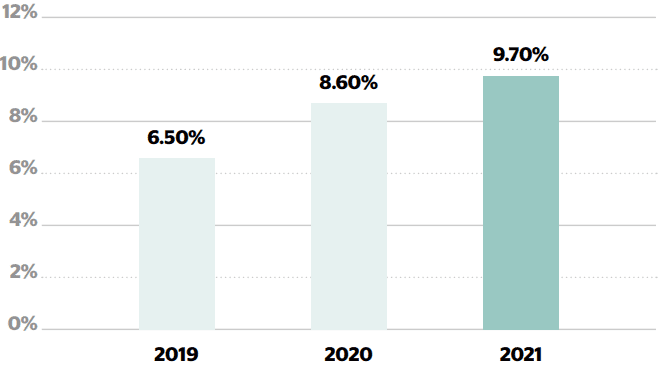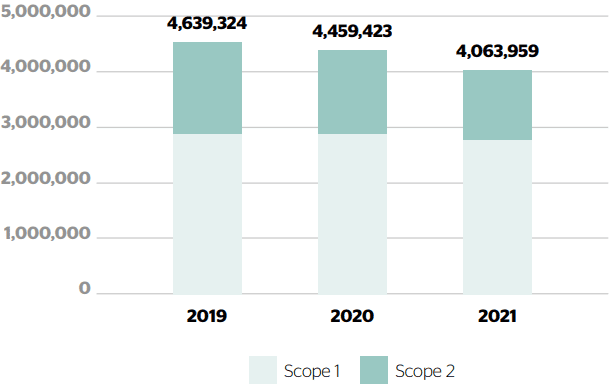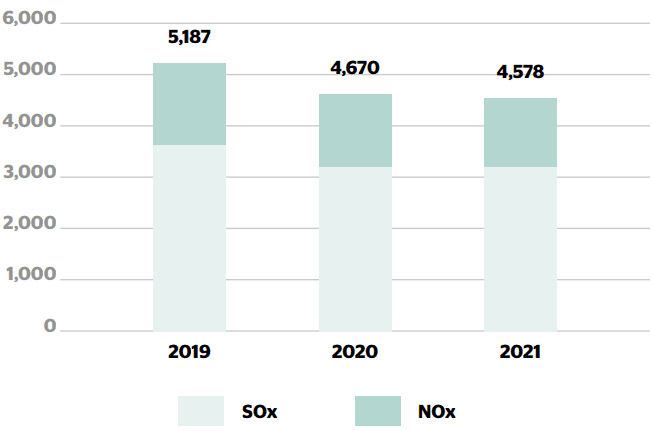Energy & Air emissions


Materiality assessment process results
Scale: [0–10], where 0 "Not significant" and 10 "Very significant"
| Boundaries of the Material Topic [GRI 102-46] [GRI 103-1b] |
|---|
| Where the impacts occur: In the areas where the aluminium and alumina production plants as well as the Company's thermal power plants operate. |
| By whom are the impacts caused: The impacts are caused by the Metallurgy and Power & Gas Business Units of MYTILINEOS and by its subsidiary KORINTHOS Power, while key suppliers of the Company may also be indirectly involved in these impacts. |
| The management of the topic by MYTILINEOS contributes to Sustainable Development:
|
| Topic of increased significance to: |
in the context of their cooperation with MYTILINEOS. |
Management Approach
[GRI 102-11] [GRI 103-2c]
The purpose of this disclosure is to provide information and data to MYTILINEOS’ Stakeholder groups, so that they can understand how the Company is managing the unavoidable impact of its business activity on air quality. [GRI 103-2b]
Key Challenges / Impacts
[GRI 103-1a] [GRI 102-15]
Aluminium production and electric power generation from thermal plants are the primary sources of the Company’s energy consumption and carbon dioxide (CO2) emissions, creating an impact on the phenomenon of climate change and representing significant operating costs. Reducing its carbon footprint and achieving a net zero footprint are the most important challenges for the Company under its new Sustainable Development Strategy.
Major risks
[GRI 102-15]
- Any deviations from the applicable legislation on industrial emissions may cause additional air pollution and result in additional costs due to the need to purchase extra CO2 emission allowances, affecting the Company's financial results as well as its capacity to retain its existing customers, investors or business partners and attract new ones.
- A further increase in the price of CO2 emission allowances (€/t), as this may be shaped by the future EU policies on energy and climate, is likely to affect future compliance costs.
Commitment
[GRI 103-2c]
Responsible use of energy and other natural resources, in accordance with the main priority areas of MYTILINEOS’
Risk Management / Control Practices
[GRI 103-2a]
MYTILINEOS has adopted specific initiatives to tackle climate change, which are outlined in the section "Adaptation to Climate Change" of this Report. The Company's targets for CO2 emissions (Scope 1 and 2) are consistent with the emission reductions required to keep global warming below 2°C by 2030, and are in line with the vision of the European Green Deal to achieve climate neutrality by 2050, as well as with the United Nations’ Sustainable Development Goals. MYTILINEOS aims, until 2026, to complete a large part of its 1.5GW RES investment plan in Greece, to have made significant progress in the electrification of the Metallurgy Business Unit from renewable energy sources, to have increased the production of secondary aluminium to 26% of its total aluminium production, and to have integrated basic digital industrial methods into the production stages. At the same time, the implementation of relevant initiatives such as the use of electric vehicles in the Sustainable Engineering Solutions (SES) and Renewables & Storage Development (RSD) Business Units is ongoing.
As part of the Company’s promotion of the use of natural gas as a transition fuel to the "green energy" era, the construction of the new combined cycle gas-fired (CCGT) power plant was completed in late 2021, making the Agios Nikolaos Energy Centre in Viotia a new national energy center. The new plant has a thermal efficiency of over 63%, a capacity of more than 826 MW as well as the possibility of using fuel mixes with hydrogen or biogas instead of natural gas, thus constituting a powerful instrument that can be used in the coming years to achieve the climate goals of MYTILINEOS. Today, it is the most powerful power plant in the country and one of the largest power plants in Europe, strengthening and ensuring electrical sufficiency in the country and the energy transition.
At the same time, MYTILINEOS:
- Closely follows the relevant developments in the legislation and takes preventive measures in order to minimize any potential adverse impacts.
- Invests in renewable energy sources and in the use of digital industrial methods in the production stage, with the aim of saving energy, reducing dependence on fossil fuels and reducing air emissions. It should be noted that the 10-year collaboration of the Metallurgy Business Unit with General Electric for the development of the world’s first Digital Smelter, the first digital solution introduced in the operation of the electrolysis process, is continuing. ASI
- Expands its activities in recycling aluminium scrap from end-of-life products and by acquiring the relevant know-how, it greatly strengthens its efforts to substantially reduce the use of raw materials (bauxite) and save energy. More specifically, in 2021 the production of secondary aluminium increased by 20%. ASI
- Systematically implements Best Available Techniques (BATs) in its production processes and by using more environmentally friendly fossil fuels such as natural gas —recognized as a transition fuel towards decarbonization— in nearly all its industrial units, it aims to improve its energy efficiency and reduce dust emissions.
- Ensures the proper maintenance and the best possible operation of the machinery in its industrial plants, while investing in their modernization with new technological equipment, where feasible. In 2021, EPALME S.A., a MYTILINEOS subsidiary active in the production of secondary aluminium, completed its investment in the purchase of a new anti-pollution technology furnace, to ensure that the strict limits of its environmental license are not exceeded. In 2021, a major scheduled maintenance of the power plant of Korinthos Power took place, lasting for 3 months.
- Monitors on a monthly basis its emissions of CO2, Fluorine and PFCs (Perfluorocarbons) and implements timely corrective actions and appropriate technical interventions to ensure that the respective annual emissions are below its statutory allowance and are maintained at the lowest possible level.
- Carries out checks of other pollutants emissions (NOx, SOx and particles) by means of continuous and periodic sampling measurements. In the Aluminium production plant, equipment has been installed to monitor and record dust emissions and take measurements in accordance with the environmental legislation and the Company's standards. In the Company’s electric power generation plants (Combined Heat and Power plants and thermal plants), an online NOx emissions measurement system is in operation, which automatically activates alarms if the "high" values set (which in any case are lower than the maximum allowed ones) are exceeded. Measures to suppress diffuse dust are also taken, such as maceration of roads and raw materials, as well as tree-planting. In the Metallurgy Business Unit, emissions of pollutants other than greenhouse gases are systematically calculated, while since 2022, specific targets have been set for further reducing these emissions. The main relevant actions concern the following:
- Optimization of the fuel mix used in the production process, mainly by replacing all fuel oil with natural gas.
- Search for and pilot testing of desulphurization solutions.
- Operation of the new filter in the anodes production process and effective retention and recycling of fluorinatedemissions.
- Constant effort to source low-sulphur coke shipments.
- Has ensured that in all its existing industrial plants all the statutory greenhouse gas emission licenses have been obtained. Moreover, appropriate emission monitoring and reporting infrastructure has been deployed and is in operation.
- In electricity generation, due to the nature of the activity, the Company focuses on maintaining the operation of thermal power plants at the highest efficiency levels in Greece, making the best use of natural gas as a primary fuel. MYTILINEOS’ thermal power plants use natural gas to generate electricity. This is a fossil fuel with a lower carbon content than other fossil fuels, without release of SO2 and particulates, lower NOx emissions (mainly NO2) compared to the limits allowed by the applicable law, and low CO2 emissions (by 70%) compared to lignite plants.
- Participates in the Emissions Trading Scheme (EU ETS), through the Metallurgy Business Unit (since 2005) and the Power & Gas Business Unit (since 2012). Since 2020, the new permits have been issued and all procedures for calculating and verifying air emissions are being followed in compliance with the EU ETS Phase IV (2021-2030) regulations, under which compliance costs are higher, due to the allocation of a constantly decreasing number of free allowances relative to the actual emissions. ASI
- In 2021, the decision was taken to carry out in the near future a preliminary study for the installation of carbon capture systems at the facilities of Aluminium of Greece, in collaboration with a leading company in this field worldwide.
Results
[GRI 103-3a-ii] [SASB EM-CM-110a.1] [SASB EM-MM-110a.1] [SASB IF-EU-110a.1] [SASB EM-CM-120a.1] [SASB EM-MM-120a.1] [SASB IF-EU-120a.1] [SASB EM-CM-130a.1] [SASB EM-MM-130a.1]
In 2021, the total energy consumption decreased by 4% due to the maintenance of the Korinthos Power plant. In particular, the total energy consumption from conventional energy sources (natural gas, diesel, gasoline) decreased by 2.5%. The quantity of electricity purchased for consumption increased slightly (by 1.4%), with nearly 31% of it coming from renewable sources.
At the same time, in 2021 there was an increase in the production of energy from RES, which represented 9.7% of the total electricity produced.


| Total energy consumption | 2019 | 2020 | 2021 |
|---|---|---|---|
| Energy consumption (Non-Renewable sources) | 43,010.9 | 44,298.7 | 41,940.6 |
| Natural Gas | 42,577.9 | 43,860.3 | 41,431.5 |
| Mazut (Fuel oil) | 280.1 | 297.0 | 332.1 |
| Gas oil (Diesel) | 138.7 | 129.5 | 156.7 |
| Heating oil | 7.1 | 6.0 | 11.5 |
| Gasoline | 6.7 | 5.4 | 8.7 |
| Energy purchased (Electric Power) | 10,342.1 | 10,323.2 | 10,483.1 |
| Non-Renewable Sources | 8,093.5 | 7,457.2 | 7,219.4 |
| RES (Renewable Energy Sources) | 2,248.6 | 2,866.0 | 3,263.7 |
| Quantity of energy produced | 20,816.5 | 21,856.6 | 20,235.6 |
| IPP (Thermal plants) | 15,286.4 | 15,622.7 | 13,757,6 |
| CHP (Combined Heat and Power Plant) | 4,167.4 | 4,351.3 | 4,518.3 |
| RES (Renewable Energy Sources) | 1,362.7 | 1,882.6 | 1,959.7 |
| Quantity of energy exported (sold) | 20,816.5 | 21,856.6 | 20,235.6 |
| IPP (Thermal plants) | 15,286.4 | 15,622.7 | 13,757,6 |
| CHP (Combined Heat and Power Plant) | 4,167.4 | 4,351.3 | 4,518.3 |
| RES (Renewable Energy Sources) | 1,362.7 | 1,882.6 | 1,959.7 |
| Total energy consumption | 53,353.0 | 54,621.9 | 52,423.7 |
In terms of energy intensities in the Metallurgy Business Unit, the specific consumption in the production of bauxite recorded an increase by 6.7%. At the same time, a decrease of 2.6% was observed in the specific consumption in the primary electrolysis aluminium production, while the specific consumptions in the production of anhydrous and hydrated alumina did not record significant changes. In the Power & Gas Business Unit, the specific energy consumption in production per TJ of electric power remained stable compared to the previous year. ASI
| Basic energy intensities [GRI 302-3] | 2019 | 2020 | 2021 |
|---|---|---|---|
| Metallurgy Business Unit | |||
| Specific consumption in bauxite production (GJ/t of production)Combined consumption of electric power, gas oil & heating oil. | 0.118 | 0.134 | 0.143 |
| Specific consumption in anhydrous alumina production (GJ/t of production)Combined consumption of natural gas, electric power, gas oil & heating oil. | 3.21 | 3.12 | 3.15 |
| Specific consumption in hydrated alumina production (GJ/t of production)Combined consumption of steam, electric power, diesel DFB, gas oil & heating oil. | 5.76 | 5.85 | 5.92 |
| Specific consumption in primary electrolysis aluminium production (GJ/t of production)Combined consumption of electric power, gas oil & heating oil. | 51.57 | 51.76 | 50.4 |
| Specific consumption in primary smelter aluminium production (GJ/t of production)Combined consumption of natural gas, electric power, gas oil & heating oil. | 1.83 | 2.10 | 2.16 |
| Specific consumption in anodes production (GJ/t production)Combined consumption of natural gas, electric power, mazut, gas oil & heating oil. | 4.20 | 4.05 | 4.01 |
| Power & Gas Business Unit | |||
| Specific production consumption (GJ of natural gas consumption/GJ of electricity production) | 1.65 | 1.65 | 1.60 |
The MYTILINEOS Metallurgy and Power & Gas Business Units produce over 99% of the Company’s direct and indirect carbon dioxide (CO2) emissions. Direct (Scope 1) emissions result primarily from the alumina and aluminium production process (consumption of fuels and chemical processing as part of the production process) and from the generation of electricity (through the consumption of natural gas), while indirect (Scope 2) emissions correspond primarily to the consumption of electric power for the production activity of the Metallurgy Business Unit. In 2021, direct CO2 emissions (Scope 1) recorded a reduction by 5.5%, due to the scheduled major maintenance of the Korinthos Power plant, while indirect CO2 emissions (Scope 2) also recorded a reduction by 15% due to the further use of RES. The above changes resulted in an overall reduction of Scope 1 & 2 emissions by 8.9% compared to 2020.

In 2021, MYTILINEOS created an integrated system for recording the sources of Scope 3 emissions and for calculating these emissions from all Company Business Units. Through this exercise, the Company calculated for the first time all the categories of indirect Scope 3 emissions, which are presented below. The exercise also helped identify the categories that contribute the most to the Company's overall carbon footprint (C1, C2, C3, C10, C11). At the same time, ways of reducing the Scope 3 carbon footprint are already being examined.
| Air emissions (t CO2 eq) | 2019 | 2020 | 2021 |
|---|---|---|---|
| Direct greenhouse gas emissions (Scope 1) [GRI 305-1] | 2,798,068.3 | 2,885,465.3 | 2,726,024.0 |
| Fuels (CO2: 100%) | 2,398,364.3 | 2,467,109.0 | 2,336,038.2 |
| Processes (CO2: 74% — PFCs: 26%) | 396,284.3 | 412,671.6 | 383,734.0 |
| Transport (CO2: 100%) | 3,419.7 | 5,684.7 | 6,251.8 |
| Indirect greenhouse gas emissions (Scope 2) [GRI 305-2] | 1,841,255.3 | 1,573,958.2 | 1,337,935.2 |
| Electricity (CO2: 100%) | 1,841,255.3 | 1,573,958.2 | 1,337,935.2 |
| Total (Scope 1 & 2) | 4,639,323.6 | 4,459,423.5 | 4,063,959.1 |
| Indirect greenhouse gas emissions (Scope 3) [GRI 305-3] | - | 6,991,358 | 5,612,393 |
| C1: Purchased goods and services | - | 1,116,996.8 | 1,074,601.8 |
| C2: Capital goods | - | 703,208.2 | 819,923.4 |
| C3: Fuel- and energy- related activities not included in Scope 1 or Scope 2 | - | 1,550,852.6 | 1,231,685.0 |
| C4:: Upstream transportation and distribution | - | 10,991.0 | 13,229.7 |
| C5: Waste generated in operations | - | 56,755.6 | 47,239.6 |
| C6: Business travel | - | 569.9 | 803.1 |
| C7: Employee commuting | - | 5,169.8 | 1,914.3 |
| C8: Upstream leased assets | - | 1,141.0 | 1,155.8 |
| C9: Downstream transportation and distribution | - | 13,935.6 | 17,507.9 |
| C10: Processing of sold products | - | 1,208,145.3 | 1,153,014.0 |
| C11: Use of sold products | - | 2,271,192.9 | 1,190,582.1 |
| C12: End-of-life treatment of sold products | - | 52,399.2 | 61,892.0 |
| C13: Downstream leased assets | - | 0.0 | 0.0 |
| C14: Franchises | - | 0.0 | 0.0 |
| C15: Investments | - | 0.0 | 0.0 |
| Total (Scope 1, 2 & 3) | N/A | 11,450,781.5 | 9,676,352.0 |
| Other significant air emissions [GRI 305-7] | 5,555.2 | 5,030.8 | 4,846.4 |
| SΟx (t) | 3,634.0 | 3,190.1 | 3,214.3 |
| NΟx (t) | 1,553.3 | 1,480.0 | 1,363.4 |
| CF4 (t) | 11.8 | 13.3 | 10.8 |
| C2F6 (t) | 1.4 | 1.6 | 1.3 |
| Fluorine (t) | 258.3 | 262.2 | 210.8 |
| Particulates (t) | 94.3 | 80.5 | 41.8 |
| Volatile organic compounds — VOC (t) | 2.0 | 3.1 | 3.9 |
| |||
Regarding the other significant air emissions, the most significant changes compared to 2020 were the following:
- The reduction of the total quantity of nitrogen oxide (NOx) emissions by 7.9%.
- The significant reduction by 48.3% of the quantity of particulates. The reduction compared to the respective emissions for 2020 is mainly attributed to the operation of the FTC unit (anode furnace gas treatment), which resulted in concentrations below the maximum permissible limit of 5mg/Nm3.
- The continuous efforts, the regular inspections and the appropriate technical interventions applied for the containment of the emissions of PFCs in the anhydrous alumina electrolysis process for the production of primary aluminium, led to a reduction of about 7% of these emissions.
- Significant reductions in CF4, C2F6 and fluoride, which stood at approximately 19% respectively.

Regarding specific CO2 emissions (direct and indirect), a slight increase (0.8%) was recorded in the production of hydrated alumina, a reduction by 4.5% was recorded in the production of anhydrous alumina, while a significant reduction by 6.4% was recorded in the production of primary aluminium. Specific emissions in secondary aluminium production remained at the same level as in 2020. [GRI 305-4] ASI
| Metallurgy Business Unit Specific air emissions (t CO2 eq) [GRI 305-4] | 2019 | 2020 | 2021 |
|---|---|---|---|
| t CO2 (Scope 1 & 2) / t of hydrated alumina production | 0.401 | 0.382 | 0.385 |
| t CO2 (Scope 1) / t of hydrated alumina production | 0.004 | 0.002 | 0.002 |
| t CO2 (Scope 2) / t of hydrated alumina production | 0.397 | 0.380 | 0.383 |
| t CO2 (Scope 1 & 2) / t of anhydrous alumina production | 0.185 | 0.177 | 0.169 |
| t CO2 (Scope 1) / t of anhydrous alumina production | 0.175 | 0.169 | 0.160 |
| t CO2 (Scope 2) / t of anhydrous alumina production | 0.010 | 0.008 | 0.009 |
| t CO2 (Scope 1 & 2) / t of primary aluminium productionSpecific emissions of primary aluminium are calculated in the context of the participation of MYTILINEOS’ Metallurgy Business Unit in the International AluminiumStewardship Initiative (ASI) and in accordance with the provisions of the Aluminium Carbon Footprint Technical Support Document (WA, Feb-2018) of the InternationalAluminium Institute, for the LEVEL 1 approach. Includes electrolysis aluminium, smelter aluminium and anode production activities. | 8.70 | 6.98 | 6.53 |
| t CO2 (Scope 1) / t of primary aluminium production | 2.31 | 2.39 | 2.15 |
| t CO2 (Scope 2) / t of primary aluminium production | 6.39 | 4.59 | 4.38 |
| t CO2 (Scope 1 & 2) / t of secondary aluminium production | 0.33 | 0.33 | 0.33 |
| t CO2 (Scope 1) / t of secondary aluminium production | 0.25 | 0.26 | 0.26 |
| t CO2 (Scope 2) / t of secondary aluminium production | 0.08 | 0.07 | 0.06 |
